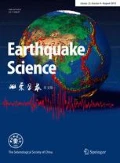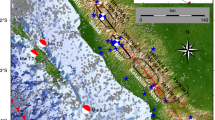Abstract
The inversion of modern tectonic stress field in China is made by regions on the basis of focal mechanism data in the period of 1920–1996. Results of the inversion show that the maximum principal compressive stress σ1 axis strikes nearly north-south direction in the Tibet Plateau and western China, east-west direction in North China. In central China, its strikes show a radiate pattern, i.e., north-north east in north part, east-west in central part and north-north west in south part. The σ1 axes are often perpendicular to the minimum principal stress σ3 axes, except western China where the σ1 axes are oblique to the σ3 axes with an acute angle. R is defined by (σ2-σ1)/(σ3-σ1), has the higher values (0.60–0.90) in north part of central China and quickly changes into the lower values (0.10–0.30) in the Tibet Plateau. Both of the observed and inverted fault planes have strikes varying with locations. Combining stress directions and R value, the stress configuration is divided into 7 groups. Most of the groups show strike-slip faulting with intermediate R values, which occupies North China and the eastern part of China as well as inner Tibet Plateau. A few of them show reverse faulting with higher R values within western part of China and the north edge of the Tibet Plateau. Normal faulting occurred on the south edge of the Tibet Plateau with smaller R values.
Similar content being viewed by others
References
Angelier J. 1979. Determination of the mean principal directions of stresses for a given population. Tectonophysics, 56: 17–26
Editorial Board of China Earthquake Yearbook. 1983–1994. China Earthquake YearBook. Beijing: Seismological Press
Du X X, Zhang H L, Lu X L, et al. 1997. Research on inversion of average stress field by genetic algorithms. Acta Seismologica Sinica, 10(2): 261–265
Ellsworth W L. 1981. A general theory for determining the state of stress in the earth from fault slip measurements. Terra Congnita, 2(2): 170–171
Gephart J W, Forsyth D W. 1984. An improved method for determining the regional stress tensor using earthquake focal mechanism data: application to San Fernando earthquake sequence. J Geophys Res, 89(B11): 9 305–9 320
Xu Z H, Ge S M. 1984. Stress field in the Fuyun, Xinjiang earthquake fractural zone determined by fitting fault slip vector data. Acta Seismologica Sinica, 6(5): 395–404 (in Chinese)
Xu Z H, Yan M, Zhao Z H. 1983. Evaluation of the direction of tectonic stress in North China from recorded data of a large number of small earthquake. Acta Seismologica Sinica, 5(3): 268–279 (in Chinese)
Zhang C, Cao X L, Qu K X, et al. 1990. Source Mechanism Solutions of China. Beijing: Academic Books and Periodical Press, 34–191 (in Chinese)
Author information
Authors and Affiliations
Additional information
This study is a part of the Project 95-04-04-02-03 from China Seismological Bureau.
About this article
Cite this article
Du, XX., Shao, HC. Modern tectonic stress field in the Chinese mainland inverted from focal mechanism solutions. Acta Seimol. Sin. 12, 390–397 (1999). https://doi.org/10.1007/s11589-999-0078-2
Received:
Revised:
Accepted:
Issue Date:
DOI: https://doi.org/10.1007/s11589-999-0078-2




